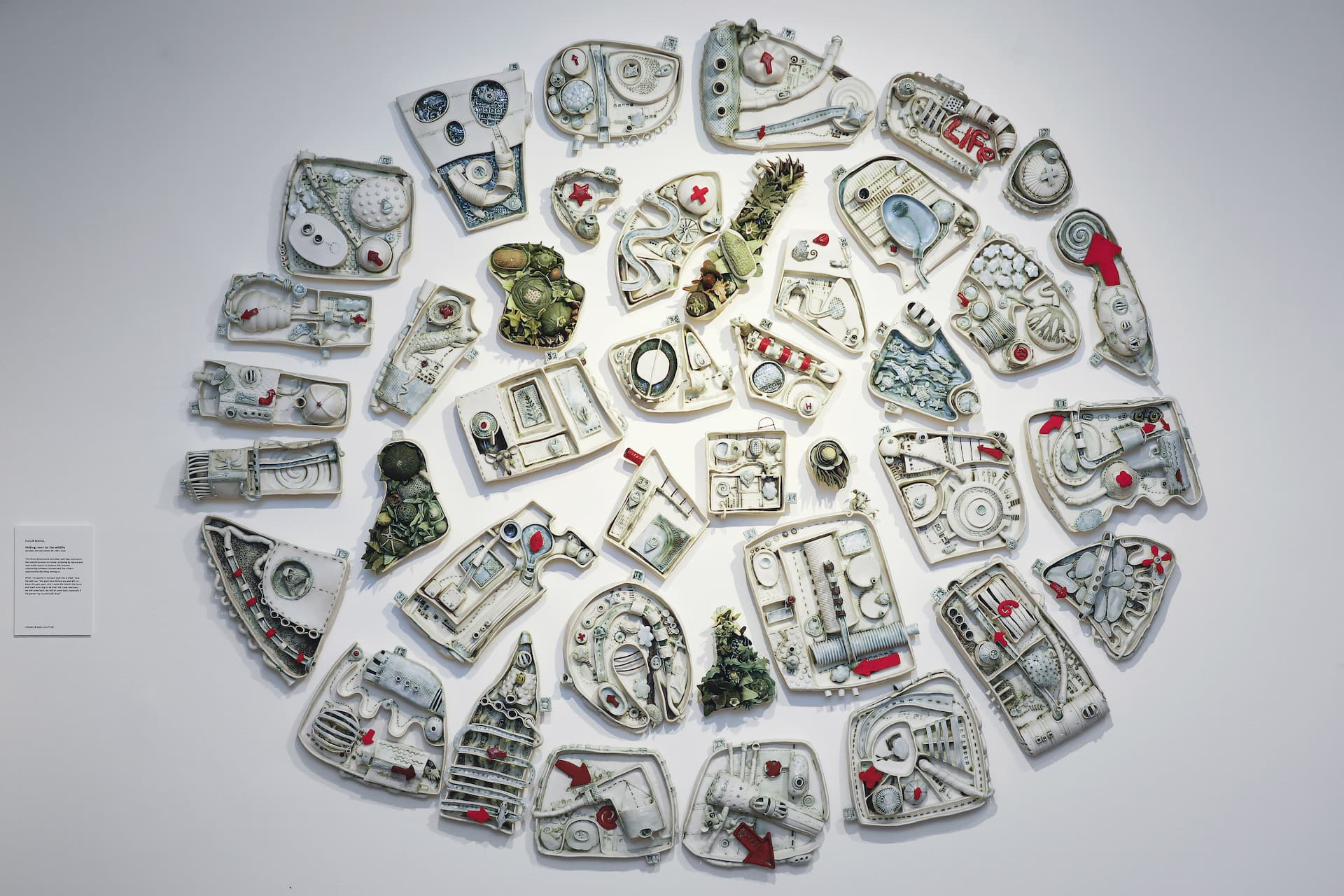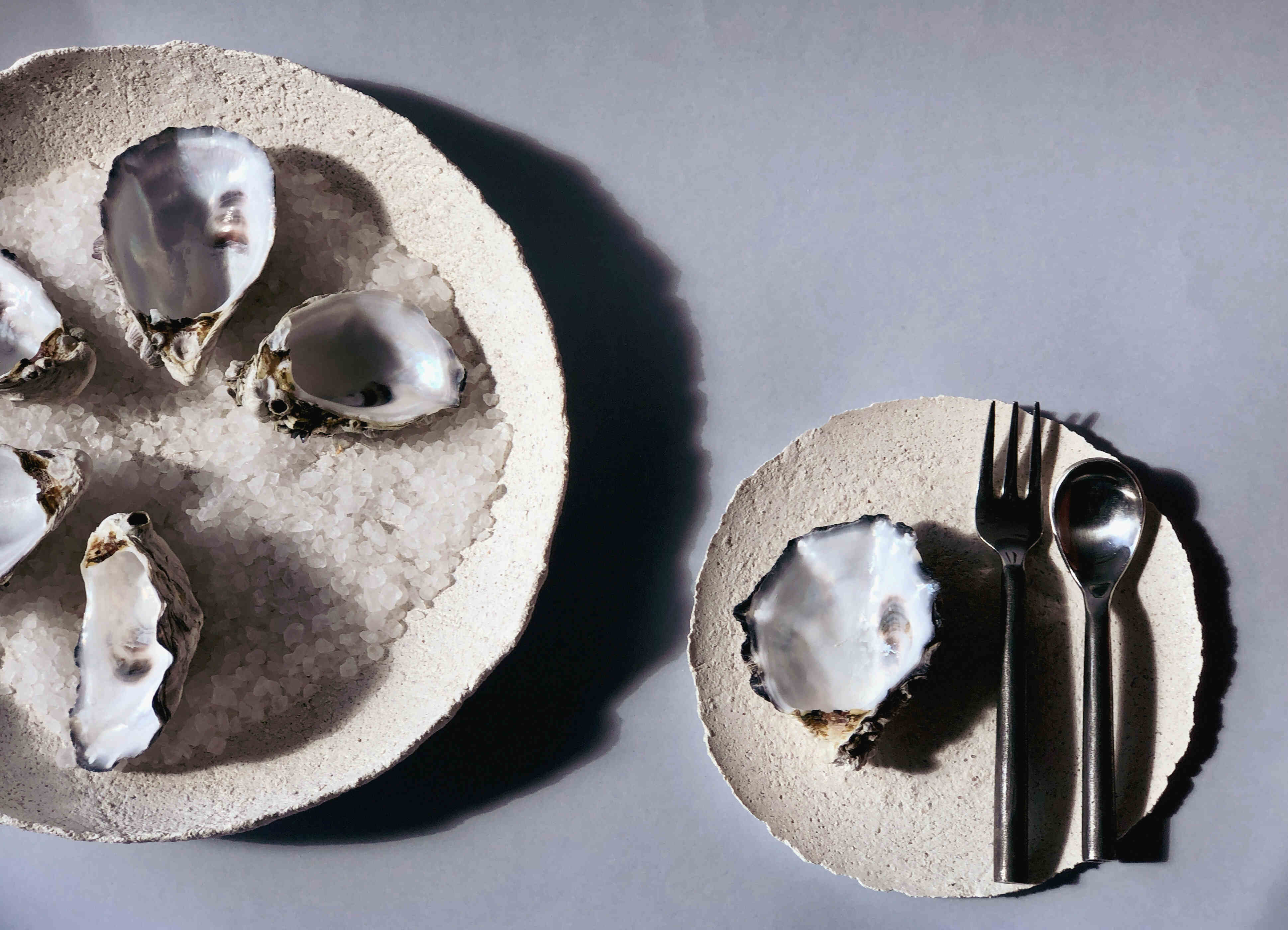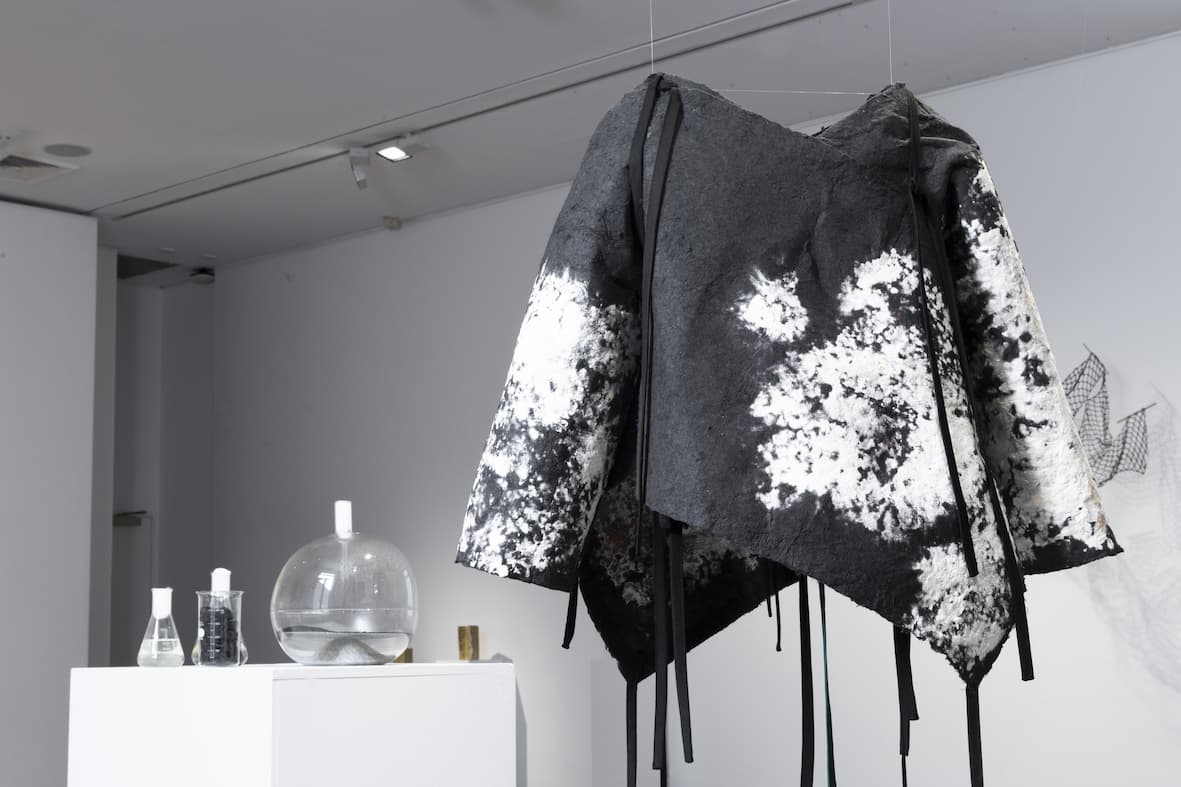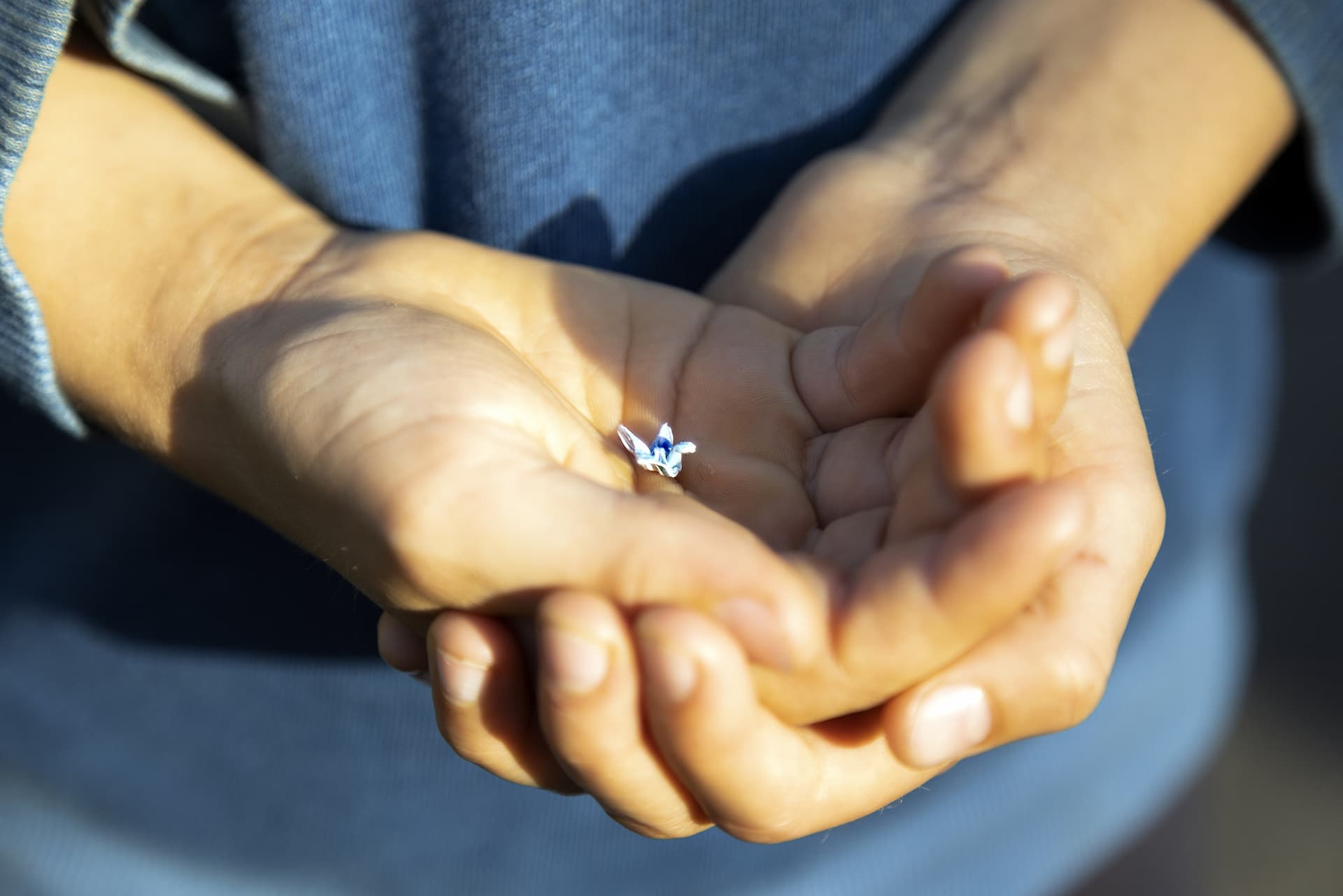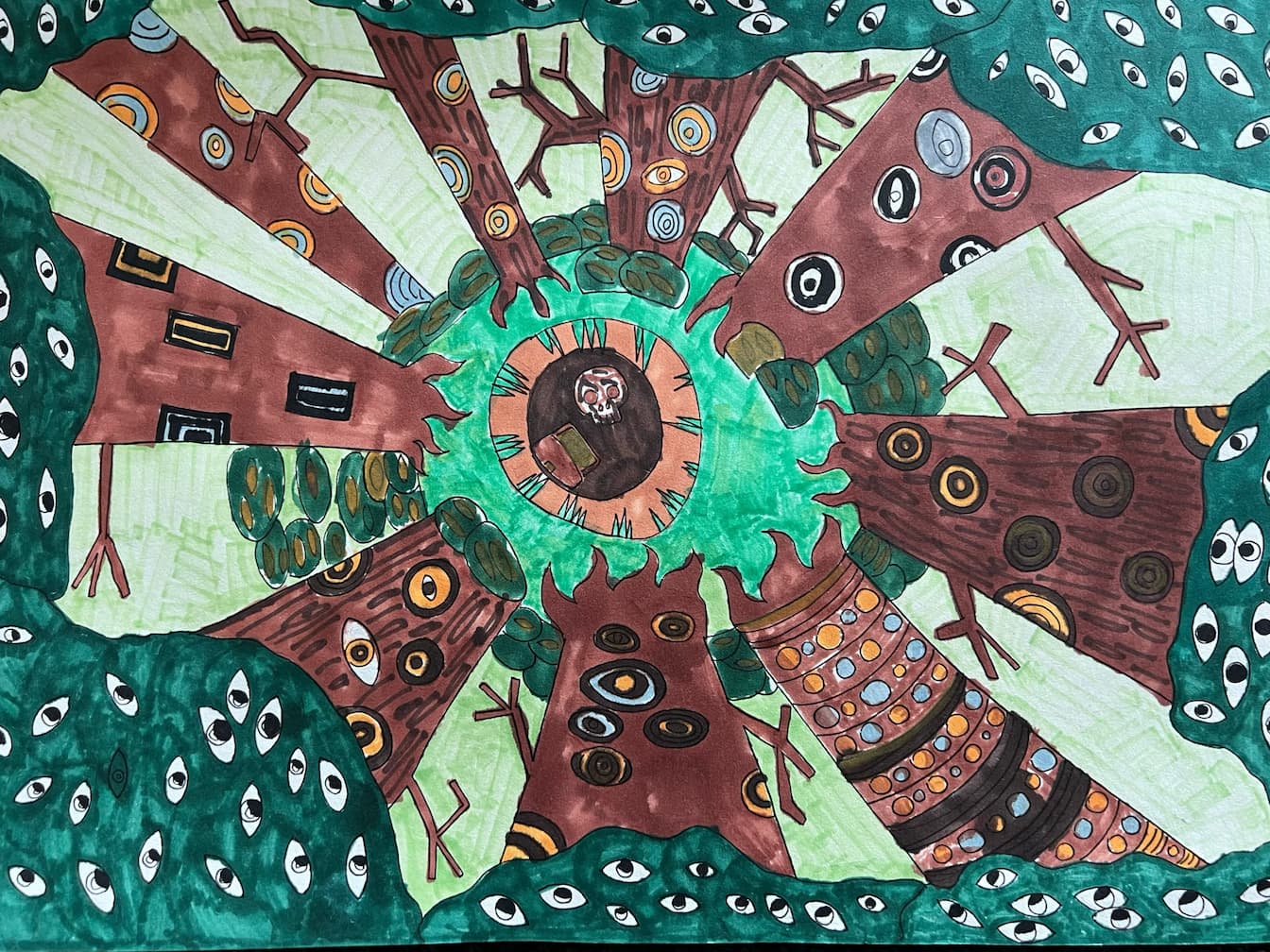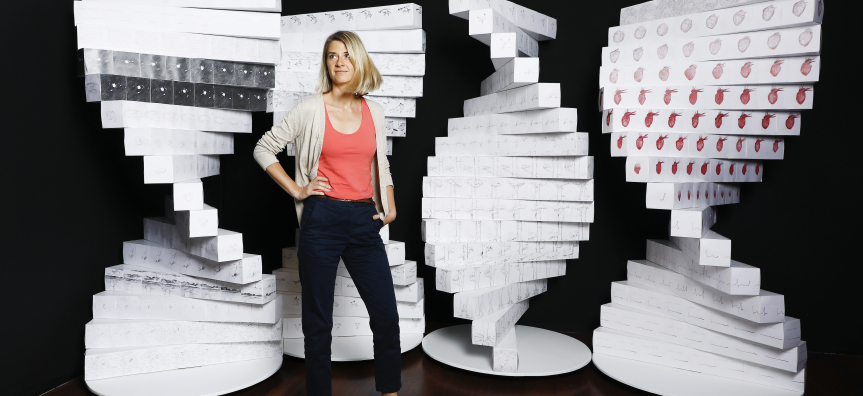
Congratulations to the winning artists and designers across the nine categories for this year’s Environmental Art & Design Prize.
The winners include:
2022 Winners
People’s Choice Winner - Manly Art Gallery & Museum
FLEUR SCHELL - Making room for the wildlife
Porcelain, wire and cement, 68 x 200 x 15cm - (Ceramics & small sculpture category)
Artist statement
This three-dimensional porcelain wall map represents the suburbs around my home, including its natural and man-made spaces. It explores the tenuous relationship between humans and the critters opportunistically living among us. When I sit quietly in my back yard this is what I hear the wild say: ‘We were here before you and left, so leave the gate open, don’t mend the hole in the fence and teach your dog to be kind. We crave sanctuary, we will come back, we will all come back, especially if the garden tap occasionally drips.
Prize
$1,000
People’s Choice Winner - Curl Curl Creative Space
DANIELLA PISKOR - Home
Acrylic paint on canvas, pallet knives and paint brushes, 50 x 50 x 4.8cm - (Young artists & designers category 13 – 18 years)
Artist statement
My artwork, Home, aims to capture the essence of our Australian bushland, and how important it is to preserve our natural backyard. With the rising demand in urbanised land, our bushlands are becoming targets for deforestation, causing a loss of biodiversity. We can see how the increase in global temperature has implemented shifts in our climate, resulting in droughts and bushfires which were prevalent throughout 2019-20. Personally, I feel a strong connection to the bush as I frequently go on bush walks where I am able to immerse in nature, allowing me to connect with my surroundings.
Overall, I want to capture the liveliness of our Australian bushland, through the use of bold lines of colour to express its vivid themes and truly encapsulate the essence of our Australian backyard, to have an everlasting memory of its diversity that is spread across the continent.
Prize
$1,000
People’s Choice Winner - Mona Vale Pop Up Gallery
LINDA HUME - Exodus - Lismore March 2022
Acrylic on canvas, 50 x 69cm - (Painting & mixed media category)
Artist statement
This work tells the story of the human toll of climate change, and of the impact of natural disasters caused by increasing global warming. The scene, the colours, and the light, all evoke the weight of loss and anxiety of a nation fleeing from safety, reminiscent of the exodus of the Israelites from Egyptian bondage and their passage through the Red Sea.
The work is a plea for Australians to acknowledge the reality of global warming and the need to change our carbon emissions and way of life.
Prize
$1,000
Ceramics and Small Sculpture
PATTIE BEERENS - Dwelling
Clay, Saltbush berries, cotton fibre, 45 x 52 x 38cm
Artist statement
Pattie Beerens creates living entanglements of relations as art. Hers is an experimental art practice exploring how the western human nature duality can be reconstructed in the mind by ‘working with’ rather than ‘doing to’ materials of the world. By sharing her love of clay earth - in collaborative performances of weaving, Pattie creates conversations about relating as kin, respect, and collaborative survival.
Dwelling (a verb), invites viewers to imagine processes in the world around them of weaving, hiding, inhabiting, and cocooning as part of nature. Made with clay respectfully collected from a mine site on Wadawurrung Country and coloured with fermenting local Saltbush berries, Dwelling forms as an ephemeral trace of becoming in the world. The clay is unfired and will be returned to the earth.
Judges’ comments
We like how this work speaks to the circularity of nature. This work comes out of nature and will return to nature and the web-like ephemeral nature of the work evokes a labyrinth structure. It feels like the work is ‘taking a line for a walk’. The work has a sense that it could keep on growing.
Prize
$5,000
Highly Commended:
CATRIONA POLLARD - Hidden deep in the forest the faeries sleep
Muehlenbeckia vine, 200 x 40 x 40cm
FLEUR SCHELL - Making room for the wildlife
Porcelain, wire and cement, 68 x 200 x 25cm
Film and video
JOANNA GAMBOTTO - Common thread
Video, 2:38mins and sculptural form
Artist statement
There is a common thread that runs through all life on our planet. Its origins date back to the beginning of time, assembled over millennia from elements forged in the furnaces of stars; a DNA molecule. The similarities in DNA across all species speak of our common ancestry and reveal the oneness of the universe and equality of all species, all playing a crucial role in the cosmic clockwork. The red thread that weaves through this animation represents a DNA molecule and symbolises life on Earth in all its diversity. The sound of a heartbeat signifies the relentless force of life and its power to prevail. The ill-treatment of our home, however, poses danger to life on our planet - a common threat.
The 1152 still images that compile the animation have been joined together to create a form reminiscent of a DNA strand. It becomes a metaphor for how the complexity of life stems from countless tiny building blocks and how our actions as individuals, seemingly small and insignificant, can contribute to the greater good, or greater bad.
Judges’ comments
This video work is moving and evocative, clearly weaving its way through our ecosystem. The drawing is brilliant and the message about the beating heart of the world is so important to convey.
Prize
$5,000
Functional Design
ELIZA CONNOLLY - Oysterware
oystershell waste, sodium alginate, water, 2 x 50 x 30cm
Artist statement
Working within a circular economy, Oysterware investigates the re-purposing of local shell waste from the seafood industry to create functional tableware.
The objects consist of three natural materials: oyster shell waste, water, and sodium alginate, a natural polymer extracted from brown algae.
When the calcium carbonate found within the shell waste combines with the water and sodium alginate, it creates a clay-like paste that naturally hardens and can then be used to form and shape objects, including plates and bowls. After use, the tableware can be reconstituted into the paste for remodelling simply by adding water, creating a re-use cycle. Alternatively, with Oysterware holding soil improvement benefits, the made objects can be sustainably disposed of in compost bins. Oysterware aims to transform the value of waste resources into critical materials, creating a functional cycle of consumption, waste production, object manufacture and re-use.
Judges comments
This work shows innovation in the use of natural waste materials and plant based sustainable materials – showing strong commitment to sustainability on several levels. The simplicity of its design and its materiality is aesthetically appealing, and the material has a strong relationship to the natural world. It would be economical to produce and using waste as a future material like this is a winner!
Prize
$5,000
Interdisciplinary collaboration
JULIA DAVIS AND JANE SHELDON - To the heart: a calling
4K video, stereo sound 12:39 minutes
Artist statement
To The Heart is the first in a collaborative series between multidisciplinary artist, Julia Davis and soprano composer, Jane Sheldon. We strive to make connections between humanity and the physical realm; where our sense of self and place is formed by the intangible forces of a world in flux and reflects upon the relationship between human and ecological fragility. Water is a reoccurring subject. 'Being there' is integral to the work. To The Heart was filmed from a small boat, kilometres off the Southernmost tip of the Tasmanian coast, from an altitude of 150 meters.
In the audio, Jane Sheldon responds to the video imagery by bringing rhythms of the ocean's immense power into a dialogue with the rhythms of the body. Using breath, she invites extreme intimacy while also suggesting the body's belonging to nature. We aim to bring these rhythms of humanity and nature into sublime proximity.
Judges’ comments
This work is compelling and meditative, referencing the planetary formation of nature’s rhythms. We were impressed by the technical proficiency of the composition in capturing the scene. The soundscape is haunting, and beautifully links us with nature.
Prize
$5,000
Highly Commended
JANE BAMFORD - Ceramic Little Penguin nesting module
handmade coil-built stoneware clay fired, partial white satin glazed exterior and black underglaze in lid cavity, 38 x 38 x 55cm
Painting and mixed media
THOMAS THORBY-LISTER - Untitled (Border)
Acrylic and oil stick on linen, 76 x 112 x 3cm
This painting focuses on an area of National Park that borders the ACT and NSW, the Namadgi National Park, belonging to the Nyamudy/Namadgi people. Using government data, 3D models and generative mapping to research the topography of the region, I've painted this aerial landscape to highlight the ecological disaster that occurred here in the Black Summer fires of 2020. The Namadgi National Park occupies almost 50% of the total landmass of the ACT.
The fire burned 82,700 ha of the National Park (about 80 per cent of the total park area), making it one of the biggest ecological disasters in ACT's history. Fires destroyed almost half of the ACT during this climate disaster. A military helicopter accidentally ignited the fire. I hope this work brings a focus to the importance of our natural landscape and the impact it faces due to critical changes to the world's climate.
Judges comments:
An emotionally evocative work depicting the loss and desolation of the environment after the 2020 Black Summer fires. Subtle, yet powerful in its simplicity and sends a strong message. Strong conceptually and technically proficient. Appears like a folded landscape.
Prize
$5,000
Highly Commended:
JENNIFER MULLEN - Shrike-tit
oil on wood panel, 22 x 22 x 18cm
Wearable Design
ALIA PARKER - My constellation jacket
Cotton textile waste, mushroom mycelium (Ganoderma steyaertanum), cotton drill fabric, 80 x 80 x 20cm
Artist statement
My constellation Jacket utilises a critical bio-design approach in the production of a modular wearable design. Discarded cotton clothing damaged beyond repair has been broken down into fibre, before being re-processed into textile sheets by using paper-making techniques. These textile planes have then been introduced to a wood-loving species of fungi. The mushroom mycelium has grown across and through the textile waste, binding the cotton fibres together in the process. The agency and expressivity of the white fungal networks look like constellations and can be seen on the surface of the material, contrasted against the recycled black textile waste.
This work contemplates the careful conditions required when working across the species divide. Fungi are incredibly adaptive organisms that are prone to boredom. They require familiar and reliable nutrients and conditions, as well as creative gustatory challenges. Therefore, practicing care for - and with - fungi in multispecies collaborative contexts, requires an attentive approach to experimentation to support the organism to flourish.
Judges’ comments:
This thought-provoking work is fascinating in the way in examines clothing production and how we could deal with cotton. Binding it mushroom mycelium is fascinating. A truly sustainable fashion item which will ultimately break down and return into the earth. This wearable is clever on many levels.
Prize
$5,000
Works on paper and photography
BELINDA FOX - The light crept in
Etching, watercolour, pencil, acrylic spray stencil, graphite
102 x 200cm
Artist statement
I have used the Raven in my work for many years. It is a bird I have a deep connection to. It is a watcher of human frailty, perhaps a bemused onlooker, I always wonder what they must think of our species. No matter where I am in this vast world, the Raven is there adapting and scrutinising our foibles and forever reminding me of my responsibility to this planet that we have so much power to preserve or destroy.
My path is connected to its path, and we must be mindful to all of nature. It is sometimes easy to overlook the common, but for me the Raven is extraordinary and this drawing is a homage to their truth telling and place in this precious world.
Judges’ comments
This work has a quiet power about it which creeps up on you, the sharing of a personal storyline and connection to nature with the big picture. It almost says ‘Nature has things on its mind and we need to take note.’ There is a lovely fluidity within the synthesizes surface of drawing, printmaking and collage. The whole composition is very integrated, with only the hand of the artist as the human presence.
Prize
$5,000
Young artist/designer 13 - 18 years
Joint winners
ELLA MCGAW - Cumulative Grief
Charcoal, earth, clay, pages of research, acrylic paint, pastel, carbon transfer, 191 x 107cm
Artist statement
My body of work documents my exploration of the continued loss inflicted by Australia’s climate-induced extreme weather events. My intent was to understand how this devastation of species, ecosystems, and the land have become insignificant, layered below conflicting human narratives surround climate change. I pulped materials from the fires and floods - charcoal, earth, clay, pages of research, newspaper articles - into paper, tonally recreating our changing landscape - black for the still charred areas, orange for the washed away earth. The resulting material tangibly represented my concept, where I could see all the conflicting narratives entangled in patterns reflecting our flooded rivers.
Judges’ comments
A very sophisticated work, with conceptual and material strength. Poetic and emotionally evocative, this work has many layers. It expresses loss and grief in a poetic yet analytical way.
Prize
$1,000
KIARA UNDERWOOD - Disconnection, destruction, extinction
Oil on canvas, 162 x 11cm
Artist statement
My artwork aims to show the immense power nature has over humans. Through my dramatic representation of nature taking back the earth, I want to create both an appreciation for it and a fear of what will happen if we continue destroying it. The small details on the road signs aim to provide hope in between all the chaos, panic, and destruction, to show the audience that while we are treading a thin line, there are solutions that could allow us to live in harmony with nature.
The ominous green colour, of the threatening stormy sky further enforces the idea that we are at a tipping point. The begonia flowers on the far left of the painting are a symbol of caution but also of harmony, a double meaning, giving us both a warning and a spark of hope about our relationship with nature.
Judges' comments
This highly detailed painting captures the fear of an uncertain future felt by many young people. The captivating sky is full of foreboding and creates a strong visual impact. An emotionally powerful work that sends a strong message about the human impact on the environment.
Prize
$1,000
Highly Commended
MEERA NIRMALENDRAN - Have you seen the black cockatoo, feathers glistening blue in the harsh summer sun?
coloured pencil on recycled paper, 65 x 47cm
JEREMY ROTENSTEIN - Ethics in a bind
pencil on wood board, 46 x 61cm
Young artist/designer 7 - 12 years
Joint winners
CAMILO BUDET TRESCOTT - The generation of peace and hope
Photograph, 100 x 150cm
Artist statement
For lots of people in the world waterbirds symbolize peace and hope. Origami is a beautiful and peaceful art that I practice every day. I made the smallest paper crane I possibly could from a tiny scrap of recycled paper, and photographed it cradled in my hands. My photo shows how important it is to look after our waterbirds because they are in danger. My wish is that my generation works together to look after nature and help to restore the habitat and populations of the waterbirds around the world.
Judges’ comments:
A poetic, thoughtful and inspiring photograph filled with hope for the future. Your generation is in good hands.
Prize
$500
LAURA MCCLELLAN - Jeremy
Acrylic on card, 26x 34cm
Artist statement
This is Jeremy the bandicoot. Bandicoots are important to the environment because they help soil production. If we lost bandicoots it would have a negative effect on plant diversity, composition of species and structure of forests and woodlands. Jeremy is a reminder of why bandicoots are very important to the ecosystem and must be protected.
Judges’ comments:
A highly evocative work which is beautifully textural. His soulful eyes really drew us in.
Prize
$500
ISABEL WADE - Souper bird (Look! Up in the sky! It’s a bird!)
Photography / graphic design, print on satin paper, 84 x 59cm
Artist statement
My name is Isabel and I really enjoy birdwatching. I took this photo of a Sooty Tern at Lord Howe Island. These seabirds are superheroes, undertaking an annual migration of almost 20,000km! My inspiration came from an artist I studied at school - Andy Warhol. I added the Rosella soup as an Australian-bird twist to Warhol’s Campbell soup series.
I really like the bold colours, which I thought matched the carefree and inquisitive Tern as it danced on the wind above me. When it came to naming my work, I thought of calling it ‘Plastic Soup’ as I know seabirds are eating the plastic that floats around in the oceans with devastating effect. Even at remote Lord Howe Island plastic washes up on the beaches and is found inside birds’ stomachs. In the end, I decided to focus on how amazing these birds are, and I hope they have a bright future - because one good Tern deserves another.
Judges' comment
This work immediately jumps out with its delightful vibrancy. This contemporary image embodies hope and is a beautiful homage to this bird.
Prize
$500
DIAN JIAO - Circle of life
marker pens on paper, 30 x 42cm
Artist statement
This illustration’s meaning is to show the danger of the environment. The treasure surrounding the trees represents that nature has something important to offer, but unfortunately humanity has ultimately destroyed much of the beauty in it, as portrayed through the skull. The eyes staring on the trees serve to personify the environment, and the patterns explain the beauty of nature. The hole in the middle shows how deep you can go in nature without going back.
Judges' comments
Strong conceptual approach, seen clearly in the work. The eyes are menacing and a reminder that nature is watching us.
Highly Commended
ZOE MASON - Lost platypus
acrylic paint, pencil, 20 x 20cm
LUCY HARTMAN - Karak - the rain bringer
pen, ink and watercolour paint, 29 x 40cm

